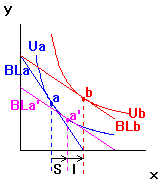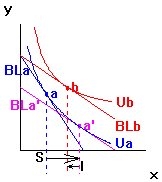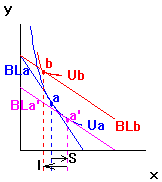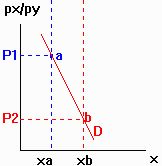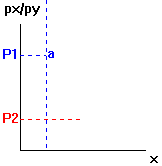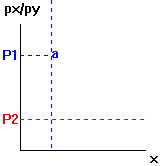|
|
Friday, February 15, 2013 |
Substitution and income effects: basic concepts
A price change affects you two ways:
(1) It changes your optimal MRS.
(2) It changes your attainable utility.
These two results underlie substitution and income effects.1. The
geometry: To see the 2 effects of a price change: slide the new BL back
to where it is tangent to the old IC.
(1) a --> a' = the substitution effect (sub)
(2) a' --> b = the income effect (inc)
2. The reasoning: A price change affects quantity demanded because
of....
(1) The substitution effect: the consumption adjustment you
make because the new price changes the relative attractiveness of the
goods you buy.
a-->a' shows this: you move along your original indifference
curve to where your MRS = the new price
Here: A lower relative price (of health food=goodX) makes you
tend to substitute health food for junk food (goodY). Makes the new BL
flatter than before, so you move to a flatter part of your original
indifference curve; this holds your utility (real income) constant.
(2) The income effect: the consumption adjustment you make
because the new price changes your attainable level of well-being.
a'-->b shows this: you move to your new indifference curve at
the new price. |
 |
These two effects determine how your consumption changes when prices change.
Suppose you consume X and Y, and the price of X falls. The two influences on
your consumption are:
1. THE SUBSTITUTION EFFECT (results from the change in
your optimal MRS): The consumer will
have an incentive to substitute the now relatively cheaper X for the relatively more
expensive Y, consuming more X and less Y until the relative value of x equals the new,
lower opportunity cost of x.
Fall in Px/Py => fall in optimal MRS (= MUx/MUy).
The substitution effect answers the question: What would happen to your
consumption of x if its price changes and your real income (utility) is held
constant instead of your money income?
2. THE INCOME EFFECT: The individual will adjust consumption
of x in the process of moving to a higher attainable level of utility at the new, lower
price of x.
Fall in Px/Py => increase in attainable U.
The income effect answers the question: What will happen to your
consumption of x as you move to a new level of welfare (utility) as a result of a price
change?
Substitution and income effects: examples
(Available online: Substitution
and income effects: alternative possibilities (Java))
For normal goods, the substitution
and income effects reinforce each other. For inferior goods, the income effect offsets
part of the substitution effect. Giffen goods are an extreme case of inferior goods in
which the income effect actually overwhelms the substitution effect.
The left-hand diagram in the bottom row illustrates the consumer's
demand curve for good X.
Diagram the demand curve for the cases of inferior and Giffen goods
illustrated above.
Can the demand curve for a normal good ever slope up? Why or why not?
Can the demand curve for an inferior good which is not a Giffen good ever
slope up? Why or why not?

